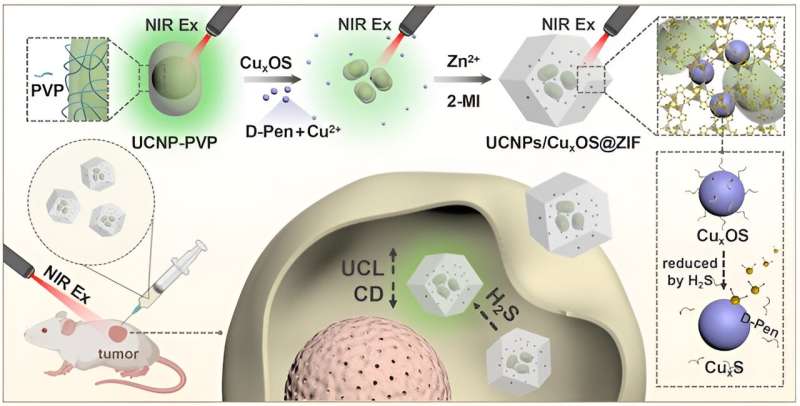This article has been reviewed according to Science X's editorial process and policies. Editors have highlighted the following attributes while ensuring the content's credibility:
fact-checked
peer-reviewed publication
trusted source
proofread
Chiral nanocomposite for highly selective dual-mode sensing and bioimaging of hydrogen sulfide

With the continuous development of nanotechnology, more artificial chiral nanomaterials have been constructed. As one of the most representative optical properties of these chiral nanomaterials, circular dichroism (CD) is a powerful sensing technology. Compared with other analytical methods, CD signal has higher sensitivity, but it cannot achieve in-situ imaging in vivo.
Scientists have managed to prepare chiral nanocomposites with more diverse biological functional properties to compensate for this shortcoming. However, some chiral nanocomposites assembled by electrostatic adsorption or other methods are easily dissociated and destroyed in complex physiological environments, resulting in performance deviations.
In addition, it is difficult for some nanocomposites to distinguish interferences with properties similar to the analyte, resulting in poor detection selectivity. Therefore, it is still a challenging task to develop chiral composite nanomaterials with stable structure and excellent properties to meet the needs of biomedical diagnosis and detection.
In a paper published in Light: Science & Applications, a team of scientists, led by Professor Geyu Lu from State Key Laboratory of Integrated Optoelectronics, College of Electronic Science and Engineering, Jilin University, China and co-workers have developed a UCNPs/CuxOS@ZIF nanocomposite probe used for in vitro UCL/CD dual-mode sensing for H2S and in vivo imaging.
In this probe, upconversion nanoparticles (UCNPs) and chiral CuxOS nanoparticles are encapsulated in zeolitic imidazolate framework-8 (ZIF-8).
The reduction of CuxOS by H2S leads to changes in CuxOS absorption and CD signal, which enables the change in UCL and CD signals of the probe. UCL/CD dual-mode sensing for H2S was realized in vitro.
At the same time, UCNPs enable in situ imaging of living tumor-bearing mice. The construction of UCNPs/CuxOS@ZIF dual-mode nanoprobes makes chiral sensing a more advantageous tool in biological detection, and provides a new idea for the application of multi-functional chiral nanomaterials in biomedicine.
UCNPs/CuxOS@ZIF as a designed chiral nanocomposite, can effectively eliminate the influence of interference in the detection environment, and achieve highly selective sensing for H2S. The scientists summarized the probe's "selection" process for H2S:
"The realization of this 'selection' actually comes from ZIF-8, which we designed as an encapsulation shell for the entire nanocomposite, not only to stabilize the composite, but more importantly, to use its unique pore structure to enable it to function as a gas molecular sieve."
"In short, H2S molecules easily enter the inside of ZIF-8, while other molecules are isolated from the outside, thus resolving some common molecular influences on probe sensing to a certain extent."
"Without the encapsulation of ZIF-8, reductive substances such as L-Cys, L-Lys, and GSH can also alter the UCL and CD signals of the probe, and this effect is extremely unfavorable for the evaluation of the sensing performance of the probe," they added.
"The assembly idea used in this nanocompositeprobe can be applied to the assembly of other kinds of composite. As long as the design is reasonable, more diversified multi-functional chiral composites can be prepared, creating more possibilities for the application of chirality in the field of biosensing, bioimaging and biotherapy, " the scientists forecast.
More information: Yang Lu et al, Upconversion-based chiral nanoprobe for highly selective dual-mode sensing and bioimaging of hydrogen sulfide in vitro and in vivo, Light: Science & Applications (2024). DOI: 10.1038/s41377-024-01539-6
Journal information: Light: Science & Applications
Provided by Chinese Academy of Sciences





















